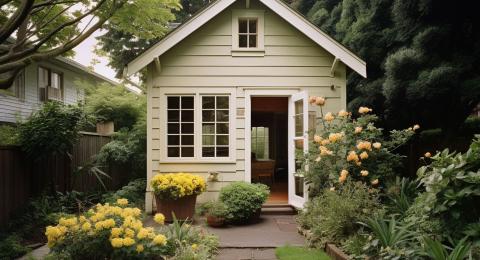Is There a Connection Between Reduced ADU Restrictions and Housing Affordability?
ADUs (accessory dwelling units) have long been heralded as part of the solution to the housing shortage, and both the NH State Legislature and the Vermont Ottauquechee ADU Study (appearing in one of my earlier blog posts) specifically state the potential of ADUs to help meet workforce housing needs. Guidance tends to be that less restrictive the ADU laws, means more ADUs will be built, and more affordable housing will be available. Alternatively, I wondered if towns that were experiencing more challenges with housing affordability would choose to restrict ADUs less. Between Saint Anselm’s newly released NH Zoning Atlas and the American Community Survey, I thought it might be time to look at the data around their implementation.
I decided to analyze one way that municipalities can control the restrictiveness of ADU laws: by either permitting or restricting detached ADUs. Unfortunately, I was not able to find a meaningful relationship between towns which had adopted a less restrictive approach to ADUs and the number of households for whom housing was unaffordable.
So—what does that mean? And what do we do about it?
First, it’s important to note that I did not control for other ways that municipalities can restrict ADUs or other measures municipalities might be taking to encourage the development or preservation of affordable housing. We need more study of the new data that has come out, and we should review the research I’ve done as well as incorporate other factors that could be at play.
However, there is also another sleeping factor that I could not get data on: the number of ADUs that have been built in the state. Nobody knows how many ADUs have been built in New Hampshire since 2017, or even how many had been permitted outside of a few municipalities. However, anecdotally we hear that numbers are relatively low, things like: “There are a few applications every year.” It’s possible that this is just not enough to make a significant dent in the housing crisis, and that we need intervention in the workforce, supply chain, and financing fields before we see a real change. Alternatively, maybe we need a communications campaign to educate homeowners that ADUs are an option and show them the potential benefits.
As municipalities, developers, individuals, nonprofits, and the state work to solve the housing crisis, we could benefit from qualitative studies on different strategies, such as the upcoming ADU tour in Peterborough or their collaboration with local banks to do outreach around ADU financing (coming soon to a CED blog post near you).
About the data
The research brief, which details my quantitative analysis, was completed over the course of a semester-long course on quantitative analysis. As a result, the newest American Community Survey (ACS) information was not available when I began the process. Future study of this issue should draw from the most updated data on housing affordability in the state, which would come from the 2023 ACS and include housing affordability data from 2017-2022.

